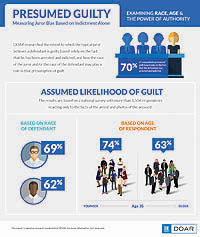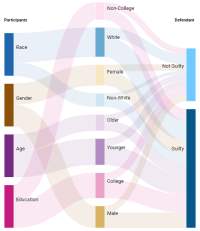Source of article DOAR Litigation Consulting.

Examining race, age & the power of authority
As experts in trial strategy who routinely assist clients involved in high-profile, white-collar criminal cases, we are always struck by the influence the federal government has over the evolution of these cases. The rules of criminal procedure and the resources of the government seem to put even the most wealthy, well-represented defendants in an imbalanced, unfair predicament. Of course, there is an even greater imbalance in more traditional criminal cases where the defendant has little or no ability to invest heavily in his defense. The DOAR Research Center was interested in quantifying this imbalance: How likely is it that the typical juror believes a defendant is guilty based solely on the fact that he has been indicted by the federal government? Does the race of the juror and/or the race of the defendant play a role in that determination of guilt? The results are surprising.
DOAR conducted a national survey of 1,506 respondents to determine the extent to which being indicted by the U.S. government is enough for a potential juror to believe the defendant is likely guilty – even before being shown any evidence whatsoever. We presented the entire sample with the same underlying story (link to narrative) but presented different respondents with different crimes (burglary, armed robbery and fraud) and manipulated the race of the defendant by including either a picture of a White male or a Black male (link to side by side pics of defendants). The narrative included only the fact of the arrest/indictment, but offered no supporting evidence.
The demographics of the survey respondents are as follows:
Unsettling Reality
The findings were unsettling: More than half the respondents presumed guilt without considering any evidence in support of either the government’s or the defendant’s case, based only on the fact that the defendant was arrested and indicted. When we account for the defendant’s race, the results are even more surprising. Respondents assumed it was more likely the White defendant was guilty than the Black defendant, by a margin of 7% (69% likelihood of guilt for White defendant, vs. 62% for Black).
Respondents also estimated a higher likelihood that the White defendant would commit another crime than the Black defendant, by a margin of 8% (61% for White, 53% for Black). But, they were also 15% more likely to believe that the White defendant would get a fair trial than the Black defendant (75% likelihood for White defendant, 60% for Black).
This last finding – the assumption that Whites are more likely than Blacks to get a fair trial – offers a window of insight into the surprising finding that Whites were presumed guilty more than Blacks were. It suggests that respondents are sensitive to the possibility of racism in patterns of arrest and indictment, and we believe that respondents are less likely to believe that a White defendant would be wrongfully accused than a Black defendant. So, if the government went so far as to indict a White male defendant, respondents assume that there is merit behind it; it is not simply a wrongful accusation with possible undertones of racism. Conversely, the perception that the government will move more quickly against a black defendant and, therefore, wrongfully accuse him makes people less likely to presume the defendant’s guilt.
Interestingly, we also saw differences in presumption of guilt based on the race of the respondent, not just of the defendant. Non-White respondents were significantly more likely than White respondents to presume guilt solely based on an indictment: 75% of non-Whites did so compared to 66% of Whites. This pattern held true for both White and Black defendants. Since, over half of our sample (about 60%) was under the age of 35, we were especially interested in how these millennials reacted to the survey scenarios compared to those 35 or older. Not surprisingly, the younger group was more likely to presume guilt based solely on indictment: 74% of the younger group did so compared to 63% of the older group. This is consistent with our experiences in pre-trial research, and with the experience of many veteran defense attorneys, particularly in the white-collar field. The youngest adults in our society are often the most punitive: Life experience and maturity serve to temper a rush to judgment, and bring an openness to the gray areas of moral judgment that young adults may not have developed yet.
High Hurdles For Defendants
The findings of this survey are sobering. The fact that a majority presumes guilt based only on the arrest/indictment suggests that the presumption of innocence afforded in the Constitution is still more of an ideal than a reality. We do not know how effective judicial instructions are in this regard. This is clearly an area deserving of further research. Still, these findings demonstrate the high hurdle for criminal defendants facing trials in federal court.
The findings also demonstrate how American jurors think about how race impacts fairness. There is a presumption that Black people are more likely to be wrongly accused and more likely to be deprived of a fair trial. Conversely, White people are more likely to be guilty if arrested because the system is perceived to work in their favor by not wrongly accusing them as often in the first place. So, how likely is it that the typical juror believes a defendant is guilty based solely on the fact that he has been indicted by the federal government? Our research showed that the answer is very likely, particularly if the defendant is White.
Of course, it only takes one juror in a criminal trial to avoid a guilty verdict and when testing actual criminal cases in advance of trial, we are not particularly discouraged to find that 3 out 10 prospective jurors would vote not guilty. Developing a sound trial strategy is about determining the questions on the verdict form that the jurors will need to answer and tailoring your presentation of the case to convince jurors to answer the questions in your client’s favor.
About DOAR
DOAR is a firm comprised of the world’s leading consulting and testifying experts. DOAR tests, develops and implements litigation strategies in complex business disputes and high-profile criminal cases across the globe, providing research-based advice, strategic communications, and industry and academic experts to advance its clients’ positions and increase their likelihood of success. Over its 30-year history, DOAR has advised on thousands of cases totaling hundreds of billions of dollars of asserted damages, including many of the highest-profile white-collar criminal cases. DOAR’s experience, commitment to excellence, and tireless dedication to its clients have earned it the trust of the world’s top law firms and corporations.
- 1
- 20
- 40
- 60
- 80
- 100
- 120
- 140+
Hover over a connections to see the percentage.
The post Presumed Guilty: Measuring Juror Bias Based on Indictment Alone appeared first on DOAR.


